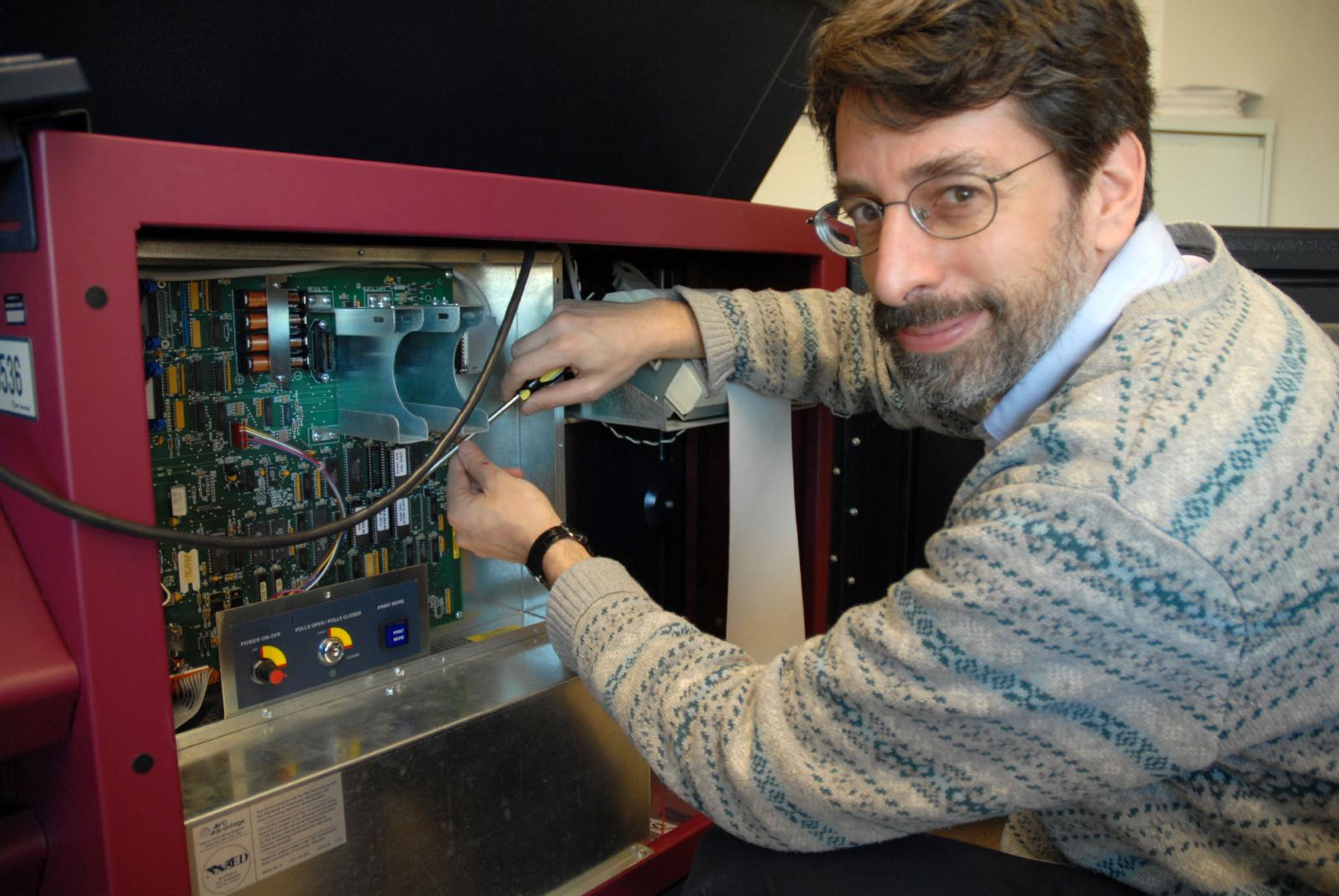Maybe you need to listen! It's shocking!
How about those precincts that elected Bush/Cheney with more votes than they had residents?
When you can't legitimately win elections, restore Jim Crow, create fraud, disenfranchisement and pretense.
Tuesday, Sep 27, 2011
Diebold voting machines can be hacked by remote control
Exclusive: A laboratory shows how an e-voting machine used by a third of all voters can be easily manipulated
By Brad FriedmanIt could be one of the most disturbing e-voting machine hacks to date.
Voting machines used by as many as a quarter of American voters heading to the polls in 2012 can be hacked with just $10.50 in parts and an 8th grade science education, according to computer science and security experts at the Vulnerability Assessment Team at Argonne National Laboratory in Illinois. The experts say the newly developed hack could change voting results while leaving absolutely no trace of the manipulation behind.
“We believe these man-in-the-middle attacks are potentially possible on a wide variety of electronic voting machines,” said Roger Johnston, leader of the assessment team “We think we can do similar things on pretty much every electronic voting machine.”
The Argonne Lab, run by the Department of Energy, has the mission of conducting scientific research to meet national needs. The Diebold Accuvote voting system used in the study was loaned to the lab’s scientists by VelvetRevolution.us, of which the Brad Blog is a co-founder. Velvet Revolution received the machine from a former Diebold contractor
Previous lab demonstrations of e-voting system hacks, such as Princeton’s demonstration of a viral cyber attack on a Diebold touch-screen system — as I wrote for Salon back in 2006 — relied on cyber attacks to change the results of elections. Such attacks, according to the team at Argonne, require more coding skills and knowledge of the voting system software than is needed for the attack on the Diebold system.
Indeed, the Argonne team’s attack required no modification, reprogramming, or even knowledge, of the voting machine’s proprietary source code. It was carried out by inserting a piece of inexpensive “alien electronics” into the machine.

The Argonne team’s demonstration of the attack on a Diebold Accuvote machine is seen in a short new video shared exclusively with the Brad Blog [posted below]. The team successfully demonstrated a similar attack on a touch-screen system made by Sequoia Voting Systems in 2009.
The new findings of the Vulnerability Assessment Team echo long-ignored concerns about e-voting vulnerabilities issued by other computer scientists and security experts, the U.S. Computer Emergency Readiness Team (an arm of the Department of Homeland Security), and even a long-ignored presentation by a CIA official given to the U.S. Election Assistance Commission.
“This is a national security issue,” says Johnston. “It should really be handled by the Department of Homeland Security.”
The use of touch-screen Direct Recording Electronic (DRE) voting systems of the type Argonne demonstrated to be vulnerable to manipulation has declined in recent years due to security concerns, and the high cost of programming and maintenance. Nonetheless, the same type of DRE systems, or ones very similar, will once again be used by a significant part of the electorate on Election Day in 2012. According to Sean Flaherty, a policy analyst for VerifiedVoting.org, a nonpartisan e-voting watchdog group, “About one-third of registered voters live where the only way to vote on Election Day is to use a DRE.”
Almost all voters in states like Georgia, Maryland, Utah and Nevada, and the majority of voters in New Jersey, Pennsylvania, Indiana and Texas, will vote on DREs on Election Day in 2012, says Flaherty. Voters in major municipalities such as Houston, Atlanta, Chicago and Pittsburgh will also line up in next year’s election to use DREs of the type hacked by the Argonne National Lab.
Voting machine companies and election officials have long sought to protect source code and the memory cards that store ballot programming and election results for each machine as a way to guard against potential outside manipulation of election results. But critics like California Secretary of State Debra Bowen have pointed out that attempts at “security by obscurity” largely ignore the most immediate threat, which comes from election insiders who have regular access to the e-voting systems, as well as those who may gain physical access to machines that were not designed with security safeguards in mind.
“This is a fundamentally very powerful attack and we believe that voting officials should become aware of this and stop focusing strictly on cyber [attacks],” says Vulnerability Assessment Team member John Warner. “There’s a very large physical protection component of the voting machine that needs to be addressed.”
The team’s video demonstrates how inserting the inexpensive electronic device into the voting machine can offer a “bad guy” virtually complete control over the machine. A cheap remote control unit can enable access to the voting machine from up to half a mile away.
“The cost of the attack that you’re going to see was $10.50 in retail quantities,” explains Warner in the video. “If you want to use the RF [radio frequency] remote control to stop and start the attacks, that’s another $15. So the total cost would be $26.”
The video shows three different types of attack, each demonstrating how the intrusion developed by the team allows them to take complete control of the Diebold touch-screen voting machine. They were able to demonstrate a similar attack on a DRE system made by Sequoia Voting Systems as well.
In what Warner describes as “probably the most relevant attack for vote tampering,” the intruder would allow the voter to make his or her selections. But when the voter actually attempts to push the Vote Now button, which records the voter’s final selections to the system’s memory card, he says, “we will simply intercept that attempt … change a few of the votes,” and the changed votes would then be registered in the machine.
“In order to do this,” Warner explains, “we blank the screen temporarily so that the voter doesn’t see that there’s some revoting going on prior to the final registration of the votes.”
This type of attack is particularly troubling because the manipulation would occur after the voter has approved as “correct” the on-screen summaries of his or her intended selections. Team leader Johnson says that while such an attack could be mounted on Election Day, there would be “a high probability of being detected.” But he explained that the machines could also be tampered with during so-called voting machine “sleepovers” when e-voting systems are kept by poll workers at their houses, often days and weeks prior to the election or at other times when the systems are unguarded.
“The more realistic way to insert these alien electronics is to do it while the voting machines are waiting in the polling place a week or two prior to the election,” Johnston said. “Often the polling places are in elementary schools or a church basement or some place that doesn’t really have a great deal of security. Or the voting machines can be tampered while they’re in transit to the polling place. Or while they’re in storage in the warehouse between elections,” says Johnston. He notes that the Argonne team had no owner’s manual or circuit diagrams for either the Diebold or Sequoia voting systems they were able to access in these attacks.
The team members are critical of election security procedures, which rarely, if ever, include physical inspection of the machines, especially their internal electronics. Even if such inspections were carried out, however, the Argonne scientists say the type of attack they’ve developed leaves behind no physical or programming evidence, if properly executed.
“The really nice thing about this attack, the man-in-the-middle, is that there’s no soldering or destruction of the circuit board of any kind,” Warner says. “You can remove this attack and leave no forensic evidence that we’ve been there.”
Gaining access to the inside of the Diebold touch-screen is as simple as picking the rudimentary lock, or using a standard hotel minibar key, as all of the machines use the same easily copied key, available at most office supply stores.
“I think our main message is, let’s not get overly transfixed on the cyber,” team leader Johnston says. Since he believes they “can do similar things on pretty much every electronic voting machine,” he recommends a number of improvements for future e-voting systems.
“The machines themselves need to be designed better, with the idea that people may be trying to get into them,” he says. ” If you’re just thinking about the fact that someone can try to get in, you can design the seals better, for example.”
“Don’t do things like use a standard blank key for every machine,” he warns. “Spend an extra four bucks and get a better lock. You don’t have to have state of the art security, but you can do some things where it takes at least a little bit of skill to get in.”
————
The video demonstration and explanation of the Diebold “Man-in-the-Middle” attack, as developed by Argonne National Lab’s Vulnerability Assessment Team, follows below. Their related attack on a Sequoia voting system can be viewed here
Investigative journalist and broadcaster Brad Friedman is the creator and publisher of The BRAD Blog. He has contributed to Mother Jones, The Guardian, Truthout, Huffington Post, The Trial Lawyer magazine and Editor & Publisher.
http://www.salon.com/2011/09/27/votinghack/
And just in case you think the Republicans are being unfairly targeted --
Monday, Feb 27, 2012
Voter fraud retires shameless GOP official
A lot of Republicans complain about voter fraud. Indiana Secretary of State Charlie White actually committed it
By Brad Friedman
Charlie White(Credit: AP/Darron Cummings)
It’s OK if you’re a Republican. Even if you commit voter fraud. Even if you are found guilty of three felony counts of voter fraud by a jury of your peers. Even if you are found guilty of six felony counts overall. Even if you are the secretary of state – the chief election official – of the first state in the union to institute polling place photo ID restrictions which Republicans claim are meant to prevent voter fraud but actually succeed only in keeping longtime voters (like 80- and 90-year-old nuns) from being able to cast their previously legal votes.
http://www.salon.com/writer/brad_friedman/



No comments:
Post a Comment